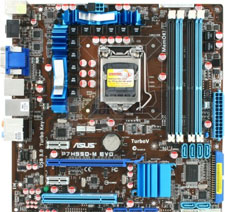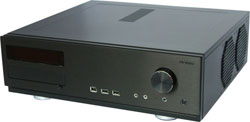Holiday 2010 System Builder's Guide
by AnandTech Staff, edited by Jarred Walton on November 19, 2010 2:00 AM EST- Posted in
- Guides
- Systems
- Holiday 2010
| Ganesh's Midrange HTPC | ||
| Hardware | Component | Price |
| Processor |
Intel Core i5-650 Clarkdale 45nm (Dual-core + HTT, 3.2 to 3.46 GHz, 4MB L3, 73W) |
$113 |
| Motherboard |
ASUS P7H55D-M EVO (Intel H55, USB 3.0, MATX 1156) |
$180 |
| Video | Clarkdale Integrated Intel HD Graphics | $0 |
| Alternate GPU | HIS Silence Radeon HD 5570 1GB (H557HR1G) | $75 |
| Alternate GPU |
Zotac GeForce GT 430 1GB Zone Edition 1GB (ZT-40601-20L) |
$85 |
| Memory |
G.Skill Eco Series 2x2GB DDR3-1600 (F3-12800CL8D-4GBECO) |
$83 |
| Hard Drive |
Seagate Barracuda XT 2TB (ST32000641AS 7200RPM 64MB SATA 6.0Gbps) |
$170 |
| Optical Drive |
ASUS 8X Blu-ray/16X DVDR Combo Drive (BC-08B1ST) ($20 MIR) |
$69 |
| Power Supply |
Antec TruePower New TP-550 550W (80 Plus Bronze Certified) |
$92 |
| Case | Antec Black Fusion Remote MATX HTPC | $135 |
| Total System Cost (Price range based on GPU choice) | $842-$927 | |
The PC I've put together is not meant to be a powerful gaming machine/HTPC combo—Alan will cover that next. Instead I've specced out a midrange build that tries to do a bit of everything, while making sure that it excels at HTPC duties. Some of the components are left to choice, depending on the needs of the end user. For example, if gaming and support for native video refresh rates are not necessary for the end user, there is no need to invest in a dedicated graphics card. Similarly, the level of interest in 3D would influence whether to go the NVIDIA or the AMD route for the dedicated graphics card—and how high you might want to go. Many of the components in the system are similar to Balraj's value build, and the cost conscious consumer can refer to that for some of the costlier components in the table below.

For the motherboard, I went with the ASUS P7H55D-M EVO mATX. It is slightly costlier than the ASRock board chosen by Balraj, but you get the option to slot in extra DIMMs and take the total memory installed up to 8GB (or 16GB if you go with 4GB DIMMs). For the CPU, a quiet, dedicated HTPC can make do with Balraj's choice, but I prefer something with more muscle and the ability to Turbo Boost. The Core i5-650 is ideal. The stock cooler is good enough and considering the airflow allowed by my choice of chassis (more on this further down), there is little need to go for a fancier cooling solution.
The DRAM is one of the most understated components in an HTPC build. DIMMs that operate at higher voltages tend to heat up and have a reduced lifespan and also affect the nearby motherboard components. Fortunately, G.Skill has an excellent HTPC oriented DRAM product in the Eco series. 4GB of G.Skill Eco memory wraps up this department. We opted for the CL8 memory, though care needs to be taken to adjust the ASUS motherboard BIOS settings appropriately for the voltage (1.35V) and CAS latencies.
As mentioned earlier, the integrated GPU in the Clarkdale is good enough for most HTPC purposes. However, people wanting a bit more muscle in the gaming department and better video quality should go in for an AMD HD 5570. The better 3D solution right is the GeForce GT 430, which performs as well as the 5570 in most HTPC benchmarks. For people who have already invested in the 3D ecosystem for the rest of their home entertainment, the GT 430 is the way to go. You could try adding a "near-silent" GPU with more performance, but my focus is on keeping things as silent as possible so I limited my selections to fanless GPUs.
For storage, the WD Caviar Blue 500GB is still an option, but I feel that the capacity is too low for a desktop HTPC. Sometimes, I want to do some video editing too, and a fast hard drive helps. The 2TB Seagate Barracuda XT is the best combination of capacity, performance, quietness and price right now. If you want a bit of added performance, the Kingston SSD Now is quite cheap, with deals for the 128GB version coming in at $180. This could be an ideal OS drive choice too, but it increases the cost of the system too much and I wanted to invest the extra money in something that would last through multiple HTPC builds. The ASUS Blu-ray Combo Drive BC-08B1ST is my choice of optical drive for the system. The 8x speed ensures that 3D Blu-ray can also be read without issues. It's a little extra money that I believe is well spent for a reusable component.

The HTPC case is something that I expect to last beyond the usual life of a motherboard and processor. For HTPC purposes, I also like to have an MCE remote / IR receiver. LCD displays and volume controls are icings on the cake. If you're willing to increase your budget, the feature packed Antec VERIS Fusion Remote Max has multiple drive bays and support for ATX motherboards. This would ensure the reusable nature of the case for purposes other than a pure HTPC. However, I wanted to keep costs down so I decided to go for its smaller sibling. The Antec Fusion chassis has similar features with respect to media center capabilities but supports only two internal 3.5" drives and can support only Micro ATX and Mini ITX motherboards. The spacious and well ventilated chassis, along with the three partition internal structure, maintains a cool thermal profile for your HTPC even when the chassis fans are removed.
Unfortunately, the chassis doesn't come with a PSU. Allowing for builds with gaming GPUs requiring external PCI-E power connectors, I budgeted for the well reviewed Antec TruePower New TP-550 550W PSU. With a partially modular cable system, unused cables can be safely stowed away for later use while maintaining a clean assembly inside the chassis.
I have never been interested in the TV content that cable connections have offered. With online streaming becoming so popular, it shouldn't be difficult to view most content on the Internet. However, interested users can add a Hauppauge WinTV tuner to the system if streaming video isn't sufficient.
In the end, depending on your choices for the GPU and optional tuner, we have a good HTPC build that costs anywhere from $850 to $1050 (the higher price includes the GT 430 and WinTV tuner). That's a bit higher than we'd like for a midrange HTPC, but we put some extra money into reusable components. You can build the above system now and upgrade to the Sandy Bridge successor (Ivy Bridge) while keeping several hundred dollars worth of equipment, or you can take the above but wait for Sandy Bridge to come out.










112 Comments
View All Comments
prdola0 - Friday, November 19, 2010 - link
In some of the systems, I would buy a GTX460 1GB instead of the HD6850 simply because most people play in 1920x1200 and lower (I would say 1680x1050 as the most common) and in those resolutions the GTX460 is better than the HD6850. It would be also a choice for the next generation of games, if the consoles ever let it come. Otherwise very nice systems.One question though, are all those memories you guys used from QVLs of the motherboards or do you just trust them?
Thanks a lot,
Prdola
ganeshts - Friday, November 19, 2010 - link
The components suggested in my mid-range HTPC build are all tried and tested together :)therealnickdanger - Friday, November 19, 2010 - link
It would be cool if each of these builds was benched and the results were shown... :) I know that's asking a lot, but like Brian said:"Heck, there's no reason you can't at least ask for the absolute best..."
AnnihilatorX - Saturday, November 20, 2010 - link
I'd personally go for HD6850. It runs cooler, uses less power, can double up as high quality sound card (if you have a AV receiver with HDMI, Radeon HD68xx support DTS Master HD, etc).prdola0 - Monday, November 22, 2010 - link
The GTX460 can of course also double up as a high quality soind card. Why wouldn't it?blotto5 - Saturday, November 20, 2010 - link
for 1680x1050 it does perform better, but not by much. for 1920x1200 there is almost no difference, and for any resolution higher than that the 6850 blows it out of the water. when your have an amd processor and an amd chipset it would make sense to stay on the same platform and get an amd video card, everything plays nice together that way.prdola0 - Monday, November 22, 2010 - link
Any nVidia graphics card will work just as good on an AMD system as on an Intel system. How did you find that it wouldn't? That's totally false.And your statement about no difference in 1920x1200 is only valid for the GTX460 768MB. The 1GB version is actually still better at 1920x1200. According to Steam Survey, 74.2% of players play at 1680x1050 or lower resolution and only 4.19% play at higher resolutions than 1920x1200. I still don't understand why all the reviews focus so much on the 2560x1600 resolution. I wish Ryan didn't ignore that fact in his Final Words. But world isn't perfect :)
Quizzical - Friday, November 19, 2010 - link
If Zambezi isn't going to fit Socket AM3, then someone ought to tell AMD.End of page 5 of the AMD codename decoder that they released on financial analyst day:
“Zambezi”
Market: Desktop
What is it? four-, six-, or eight-core 32-nm AM3 socket desktop processor based on
the “Bulldozer” processor architecture for the enthusiast market.
Planned for introduction: 1H 2011
If I give a link, this site apparently flags the comment as spam and disallows it. But you can find it yourself as follows. Do a Google search for "AMD 2010 Financial Analyst Day". Click the (currently) top search result, to a page on AMD's site with that headline. Click the "AMD Codename Decoder" link from that page. The above is a copy and paste from the end of the document.
Dustin Sklavos - Friday, November 19, 2010 - link
Later on in the year they did say they tried to make Bulldozer compatible with the existing AM3 socket but couldn't do it, as a result you get AM3r2, where the motherboards will be backwards compatible with old AM3 chips, but the Bulldozer chips aren't going to be compatible with old AM3 boards.Quizzical - Friday, November 19, 2010 - link
The information I quoted was released by AMD last week. "Later on in the year" than that would have to be very, very recent. As I said, if the information that AMD just released is wrong, someone should tell them to fix it.